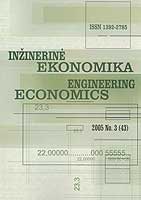Methods of Measurement of Non-tariff Barriers in the International Textile Trade
Methods of Measurement of Non-tariff Barriers in the International Textile Trade
Author(s): Vytautas Snieška, Aida ZigmantavičienėSubject(s): Economy
Published by: Kauno Technologijos Universitetas
Keywords: measurement of non-tariff barriers; international textile trade.
Summary/Abstract: Modern international trade is in the process of constant trade liberalization in goods and services: now when tariff barriers have been substantially reduced or eliminated there has been an increasing interest in the ways that non-tariff barriers might restrict or distort international trade and its dynamic. The policy of trade liberalization is changing the picture of world import and export trade. The end of quotas and import taxes are bringing to a finale a process of liberalization that started in 1995 with the aim of integrating the textile and clothing sector into GATT. The main emphasis of it was to gradually reduce quotas as the most influential non-tariff trade barrier within 10 years period of time ending in January 1, 2005. Furthermore, the traditional non-tariff barriers to trade found replacement by modern trade distortions. The article studies different methods to measure nontariff barriers and analyses those most suitable to indicate the influence of non-tariff barriers in the international textile trade. At first the article presents one of the most frequently used classification (typology) of non-tariff barriers employed to control international trade and introduces general methods for measuring the presence or size of nontariff barriers. The main part of the study is dedicated to those trade restrictions most efficient in the context of international textile trade: quantity impact measures, frequency measures and price comparison measures. The analysis of the main methods of measurement of non-tariff barriers as well as the summary of the findings from the other researches brings to the conclusion that regardless of a number of difficulties the theoretic and empiric analysis has developed and opens the opportunity to choose a corresponding trade policy to protect separate industries. It also admits that estimating tariff and subsidies equivalents and comparing them with price changes before and after the introduction of a barrier might be the best method of measurement of non-tariff barrier. The empiric test is carried out in order to prove this proposition. The object of the research – the comparable analysis of consumer prices indexes including clothing and shoes in Norway, Sweden, representing European Union and USA. The outcome of the research confirms that gradual reduction of tariff rates in the international textile trade 1995-2004 is proportional to the drop in prices on textile and clothing products. Acknowledging difficulties the article concludes that there is no the only best method absolutely efficient for measuring the presence or size of non-tariff barriers in textile and clothing sector. Every method discussed in the study depending on the aim of measurement of non-tariff barriers might be used.
Journal: Engineering Economics
- Issue Year: 2006
- Issue No: 1 (46)
- Page Range: 13-19
- Page Count: 7
- Language: English

